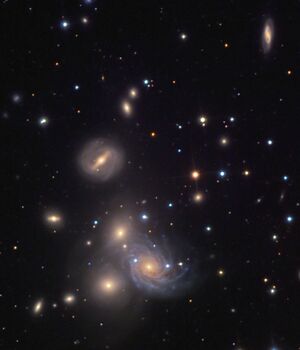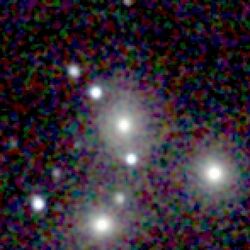Astronomy:NGC 70
| NGC 70 | |
|---|---|
 | |
| Observation data (J2000 epoch) | |
| Constellation | Andromeda |
| Right ascension | 00h 18m 22.55s |
| Declination | +30h 04m 43.4s |
| Redshift | 0.023907[1] |
| Helio radial velocity | 7167 km/s[1] |
| Distance | 320-325 Mly[2][3] |
| Apparent magnitude (V) | 13.5[4][2] |
| Characteristics | |
| Type | Sb[5] Sbc[4] SA(rs)c[2] |
| Size | 180,000[2] |
| Apparent size (V) | ~1.7'x1.4'[5][4][6] |
| Other designations | |
| IC 1539, UGC 174, Arp 113, VV 166a, MCG +05-01-067, 2MASX J00182252+3004465, IRAS 00157+2948, PGC 1194, UZC J001822.6+300446 | |
NGC 70 is a spiral galaxy located in the constellation Andromeda.[7] It was discovered on October 7, 1855, by R. J. Mitchell[7] and was also observed on December 19, 1897 by Guillaume Bigourdan from France who described it as "extremely faint, very small, round, between 2 faint stars".[2]
NGC 70 is a member of a compact group of seven[8] or eight[9] galaxies, sometimes called the NGC 70 Group or the VV 166 Group. The group consists of three relatively bright galaxies: 70, 71 and 72 in the NGC catalog, along with four fainter galaxies. NGC 68 appears to be a group member, but its discrepant radial velocity and lack of tidal distortion suggests that it may be an unrelated galaxy along the group's line of sight.[9] In photographs the NGC 70 group resembles the much more famous Stephan's Quintet group, and it is a popular target for amateur astrophotographers.

References
- ↑ 1.0 1.1 "NASA/IPAC Extragalactic Database - NGC 70". NASA/IPAC. http://ned.ipac.caltech.edu/cgi-bin/objsearch?objname=NGC+70&extend=no&hconst=73&omegam=0.27&omegav=0.73&corr_z=1&out_csys=Equatorial&out_equinox=J2000.0&obj_sort=RA+or+Longitude&of=pre_text&zv_breaker=30000.0&list_limit=5&img_stamp=YES.
- ↑ 2.0 2.1 2.2 2.3 2.4 Seligman, Courtney. "New General Catalog Objects: NGC 50 - 99". http://cseligman.com/text/atlas/ngc0a.htm#70.
- ↑ Wright, Ned. "Ned Wright's Javascript Cosmology Calculator". UCLA. http://www.astro.ucla.edu/~wright/CosmoCalc.html.
- ↑ 4.0 4.1 4.2 "NGC 70 >> Deep Sky Object Browser". http://dso-browser.com/dso/info/NGC/70.
- ↑ 5.0 5.1 "NGC 70". SIMBAD. Centre de données astronomiques de Strasbourg. http://simbad.u-strasbg.fr/simbad/sim-basic?Ident=NGC+70.
- ↑ "WIKISKY - NGC 70". SKY-MAP.org. http://server3.wikisky.org/starview?object_type=2&object_id=4678.
- ↑ 7.0 7.1 "NGC 70". Courtney Seligman. http://cseligman.com/text/atlas/ngc0a.htm#70.
- ↑ Hickson, P.; Richstone, D.O.; Turner, E.L. (April 1977). "Galaxy collisions in dense groups". Astrophysical Journal 213: 323–326. doi:10.1086/155158. Bibcode: 1977ApJ...213..323H. http://articles.adsabs.harvard.edu/pdf/1977ApJ...213..323H. Retrieved 17 November 2020.
- ↑ 9.0 9.1 Kormendy, John; Sargent, Wallace L. W. (1 October 1974). "Tidal Effects As Criteria for Membership In Small Groups of Galaxies: Application to VV166". Astrophysical Journal 193: 19–25. doi:10.1086/153122. Bibcode: 1974ApJ...193...19K. http://articles.adsabs.harvard.edu/pdf/1974ApJ...193...19K. Retrieved 17 November 2020.
External links
 |

